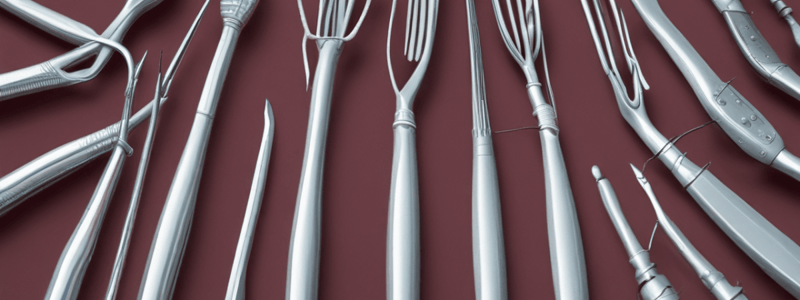Podcast
Questions and Answers
For the upper right posterior region, vestibular surface, what is the operator's position?
For the upper right posterior region, vestibular surface, what is the operator's position?
- 7 E 11-12 hours
- 11-12 hours
- 7-9 hours
- 9 hours (correct)
What is the position of the operator when working on the upper anterior region, lingual surface?
What is the position of the operator when working on the upper anterior region, lingual surface?
- 7-9 hours
- 11-12 hours (correct)
- 9 hours
- 7 E 11-12 hours
When working on the lower posterior left region on the lingual surface, what should the patient's head position be?
When working on the lower posterior left region on the lingual surface, what should the patient's head position be?
- To the upper side
- To the right side
- To the left side (correct)
- To the lower side
Which of the following operator's vision types is employed for the upper anterior region, lingual surface?
Which of the following operator's vision types is employed for the upper anterior region, lingual surface?
What is the operator's position when working on the lower posterior right region, vestibular surface?
What is the operator's position when working on the lower posterior right region, vestibular surface?
For the upper posterior left region, palatine surface, what position should the operator assume?
For the upper posterior left region, palatine surface, what position should the operator assume?
Which curette is suitable for cleaning all surfaces of anterior teeth and has cutting edges on both sides?
Which curette is suitable for cleaning all surfaces of anterior teeth and has cutting edges on both sides?
Which curette is specifically designed for cleaning the mesial surfaces of posterior teeth?
Which curette is specifically designed for cleaning the mesial surfaces of posterior teeth?
What is the primary use of a foice?
What is the primary use of a foice?
Which curette is used for cleaning the distal surfaces of posterior teeth?
Which curette is used for cleaning the distal surfaces of posterior teeth?
Which curette is utilized for cleaning the free surfaces of posterior teeth and has only one cutting edge?
Which curette is utilized for cleaning the free surfaces of posterior teeth and has only one cutting edge?
Which curette is used for cleaning all surfaces of posterior teeth and is classified as a universal curette?
Which curette is used for cleaning all surfaces of posterior teeth and is classified as a universal curette?
Study Notes
Periodontia Instrumentation Guidelines
Superior Region
- Posterior right: Operator position at 9 o'clock, patient's head turned to the left, direct vision
- Posterior right: Palatine face, operator position at 11-12 o'clock, patient's head turned to the right, direct vision
- Anterior: Vestibular face, operator position at 11-12 o'clock, patient's head facing forward, direct vision
- Anterior: Lingual face, operator position at 11-12 o'clock, patient's head facing forward, indirect-direct vision
- Posterior left: Vestibular face, operator position at 11-12 o'clock, patient's head turned to the right, direct vision
- Posterior left: Lingual face, operator position at 9 o'clock, patient's head turned to the left, direct vision
Inferior Region
- Posterior left: Vestibular face, operator position at 11-12 o'clock, patient's head turned to the right, direct vision
- Posterior left: Lingual face, operator position at 7-9 o'clock, patient's head turned to the left, direct vision
- Anterior: Vestibular face, operator position at 7 and 11-12 o'clock, patient's head facing forward, direct vision
- Anterior: Lingual face, operator position at 7 and 11-12 o'clock, patient's head facing forward, indirect-direct vision
- Posterior right: Vestibular face, operator position at 9 o'clock, patient's head turned to the left, direct vision
- Posterior right: Lingual face, operator position at 11-12 o'clock, patient's head turned to the right, direct vision
Dental Curettes
McCall Curettes
- McCall 13-14: Universal curette for all anterior teeth faces, with 2-sided cutting edge, for supragingival region
- McCall 17-18: Universal curette for all posterior teeth faces, with 2-sided cutting edge, for supragingival region
Gracey Curettes
- Gracey 5-6: Specific curette for anterior teeth faces, with 1-sided cutting edge, for subgingival region, for scaling and root planing
- Gracey 7-8: Specific curette for posterior teeth free faces, with 1-sided cutting edge, for subgingival region, for scaling and root planing
- Gracey 11-12: Specific curette for posterior teeth mesial faces, with 1-sided cutting edge, for subgingival region, for scaling and root planing
- Gracey 13-14: Specific curette for posterior teeth distal faces, with 1-sided cutting edge, for subgingival region, for scaling and root planing
Sickle or Hoe
- Instrument used to remove supragingival calculus, with triangular active tip and two cutting edges
Studying That Suits You
Use AI to generate personalized quizzes and flashcards to suit your learning preferences.
Description
This quiz covers the different types of dental curettes, including Maccall and Gracey, and their uses in dentistry.




